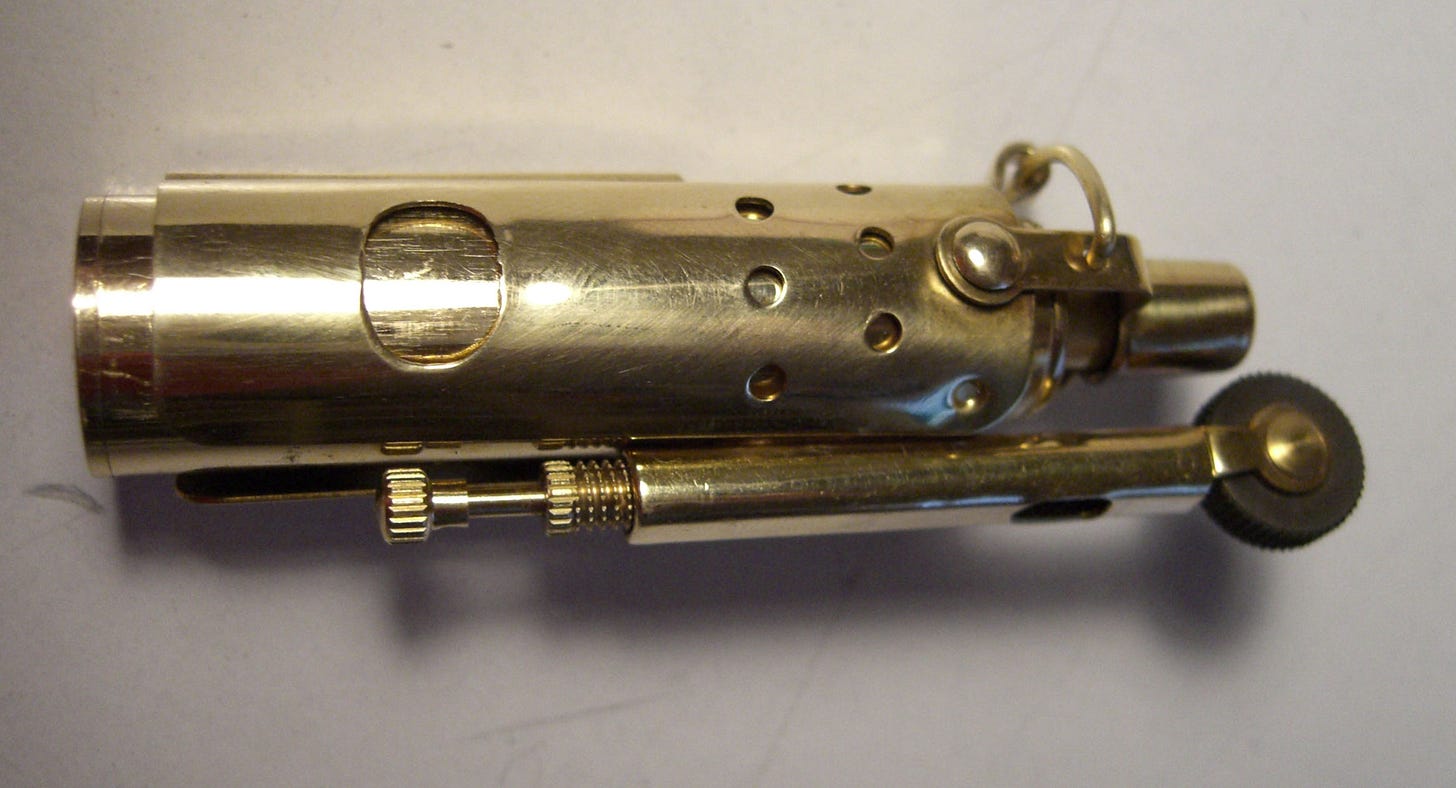Props
Mr. Beaker began fiddling with his pipe, poking and pounding at the tobacco with a complicated brass tool that my father suspected was a prop, something that Beaker used only when he had an audience. . . .
Mr. Beaker took from his pocket a brass lighter, a miniature reproduction of the sort of torch used in those days to solder copper pipe. At the back, above the little handle, was a lever that could be pumped to raise the pressure in the fuel container. From the top, a nozzle projected horizontally, terminating in a perforated sleeve, and just in front of this sleeve was a striking wheel that, when spun, produced a spark from a flint held just below the wheel in a cylindrical flint-holder. When a valve was opened, fuel was forced through the tiny nozzle under pressure, and the atomized fuel rushed through the sleeve, where it mixed with air drawn into the sleeve through the perforations. This air-and-fuel mixture was ignited by the spark and produced, with a miniature roar, a flame as long as Mr. Beaker’s index finger, a flame that Mr. Beaker could count on to capture the attention of everyone nearby. He pumped the lighter several times, opened the valve, and spun the striker, producing the desired results.Little Follies, “My Mother Takes aTumble”
prop 1
n. 1. An object placed beneath or against a structure to keep it from falling orshaking; a support. 2. One that serves as a means of support or assistance.
prop 2
n. 1. Any of the articles other than costumes and scenery used by an actor or performer during a performance on stage or in a film. [Short for property.] 2. Someone or something displayed to impress others or provide a false impression.
prop 3
n. Informal A propeller.American Heritage® Dictionary of the English Language, Fifth Edition. Copyright © 2016by Houghton Mifflin Harcourt Publishing Company. Published by Houghton Mifflin Harcourt PublishingCompany. All rights reserved.
I have been unable to find an image of a lighter exactly like the one that Peter’s father suspects that the insidious rascal Dudley Beaker uses as a prop, definition 2-2. I suspect that nothing exactly like that ever existed. The one that Dudley uses may have been inspired by the “trench lighters” of World War I.
In Michelangelo Antonioni’s 1966 film Blowup, the photographer identified only as Thomas (David Hemmings) visits an antique shop in search of a prop, definition 2-1, for a photo shoot. He spots the ideal thing: a prop, definition 3, and buys it, turning it into a prop, definitions 2-1 and 3, and possibly 2-2 as well, since his buying it gives us the impression (false? or accurate?) that he is a very literal-minded fellow; that impression is likely to influence our judgment when Thomas begins making inferences about the enlargement of a photo that may or may not reveal a murder. I think it’s one of the wittiest scenes in cinema, but maybe that’s just me.
[more to come on Tuesday, June 1, 2021]
Have you missed an episode or two or several? You can catch up by visiting the archive.



